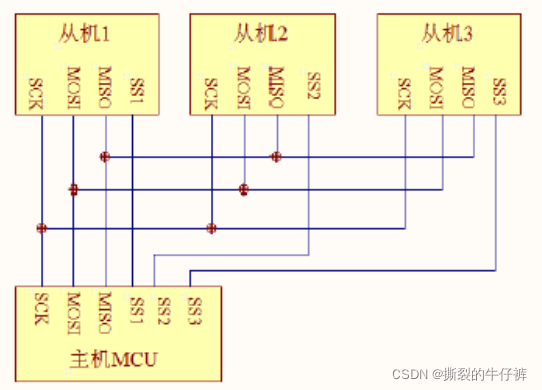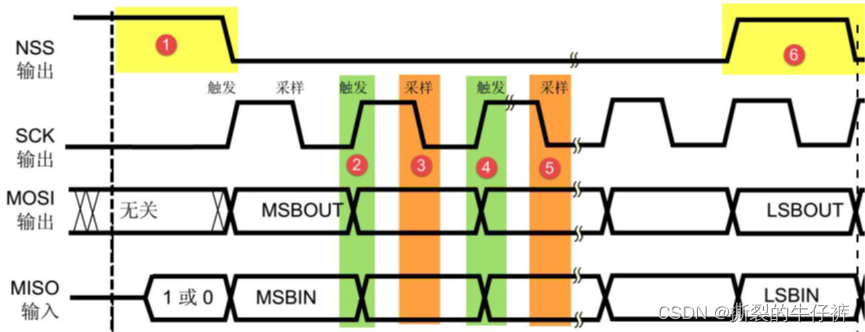SPI 协议是由摩托罗拉公司提出的通讯协议(Serial Peripheral Interface),即串行外围设备接口,是一种高速全双工的通信总线。它被广泛地使用在 ADC、LCD 等设备与 MCU 间,要求通讯速率较高的场合。
SPI 通讯设备之间的常用连接方式见图 1。

SPI 通讯使用3 条总线及片选线,3 条总线分别为SCK、MOSI、MISO,片选线为 SS
,它们的作用介绍如下:
(1) SS ( Slave Select):从设备选择信号线,常称为片选信号线,也称为NSS、CS,以下用NSS 表示。当有多个SPI 从设备与SPI 主机相连时,设备的其它信号线SCK、MOSI及MISO 同时并联到相同的SPI 总线上,即无论有多少个从设备,都共同只使用这3 条总线;而每个从设备都有独立的这一条NSS 信号线,本信号线独占主机的一个引脚,即有多少个从设备,就有多少条片选信号线。I2C 协议中通过设备地址来寻址、选中总线上的某个设备并与其进行通讯;而SPI 协议中没有设备地址,它使用NSS 信号线
来寻址,当主机要选择从设备时,把该从设备的NSS 信号线设置为低电平,该从设备即被选中,即片选有效,接着主机开始与被选中的从设备进行SPI 通讯。所以SPI 通讯以NSS 线置低电平为开始信号,以NSS 线被拉高作为结束信号。
(2) SCK (Serial Clock):时钟信号线,用于通讯数据同步。它由通讯主机产生,决定了通讯的速率,不同的设备支持的最高时钟频率不一样,如STM32 的SPI 时钟频率最大为fpclk/2,两个设备之间通讯时,通讯速率受限于低速设备。
(3) MOSI (Master Output, Slave Input):主设备输出/从设备输入引脚。主机的数据从这条信号线输出,从机由这条信号线读入主机发送的数据,即这条线上数据的方向为主机到从机。
(4) MISO(Master Input,,Slave Output):主设备输入/从设备输出引脚。主机从这条信号线读入数据,从机的数据由这条信号线输出到主机,即在这条线上数据的方向为从机到主机。
协议层
与I2C 的类似,SPI 协议定义了通讯的起始和停止信号、数据有效性、时钟同步等环节。
SPI 基本通讯过程先看看SPI 通讯的通讯时序,见图 2。

这是一个主机的通讯时序。NSS、SCK、MOSI 信号都由主机控制产生,而MISO 的信号由从机产生,主机通过该信号线读取从机的数据。MOSI 与MISO 的信号只在NSS 为低电平的时候才有效,在SCK 的每个时钟周期MOSI 和MISO 传输一位数据。以上通讯流程中包含的各个信号分解如下:
3. 通讯的起始和停止信号
在图 2 中的标号处,NSS 信号线由高变低,是SPI 通讯的起始信号。NSS 是每个从机各自独占的信号线,当从机在自己的NSS 线检测到起始信号后,就知道自己被主机选中了,开始准备与主机通讯。在图中的标号?处,NSS 信号由低变高,是SPI 通讯的停止信号,表示本次通讯结束,从机的选中状态被取消。
4. 数据有效性
SPI 使用MOSI 及MISO 信号线来传输数据,使用SCK信号线进行数据同步。MOSI 及MISO 数据线在SCK 的每个时钟周期传输一位数据,且数据输入输出是同时进行的。数据传输时,MSB 先行或LSB 先行并没有作硬性规定,但要保证两个SPI 通讯设备之间使用同样的协定,一般都会采用图 2 中的MSB 先行模式。MOSI 及MISO 的数据在SCK的上升沿期间变化输出,在SCK 的下降沿时被采样。即在SCK 的下降沿时刻,MOSI 及MISO 的数据有效,高电平时表示数据“1”,为低电平时表示数据“0”。在其它时刻,数据无效,MOSI 及MISO 为下一次表示数据做准备。SPI 每次数据传输可以8 位或16 位为单位,每次传输的单位数不受限制。
5. CPOL/CPHA 及通讯模式
上面讲述的图 25-2 中的时序只是SPI 中的其中一种通讯模式,SPI 一共有四种通讯模式,它们的主要区别是总线空闲时SCK 的时钟状态以及数据采样时刻。为方便说明,在此引入“时钟极性CPOL”和“时钟相位CPHA”的概念。时钟极性CPOL 是指SPI 通讯设备处于空闲状态时,SCK 信号线的电平信号(即SPI 通
讯开始前、 NSS 线为高电平时SCK 的状态)。CPOL=0 时, SCK 在空闲状态时为低电平,CPOL=1 时,则相反。时钟相位CPHA 是指数据的采样的时刻,当CPHA=0 时,MOSI 或MISO 数据线上的信号将会在SCK 时钟线的“奇数边沿”被采样。当CPHA=1 时,数据线在SCK 的“偶数边沿”采样。见图 3 及图 4。

我们来分析这个CPHA=0 的时序图。首先,根据SCK在空闲状态时的电平,分为两种情况。SCK 信号线在空闲状态为低电平时,CPOL=0;空闲状态为高电平时,CPOL=1。无论CPOL=0 还是=1,因为我们配置的时钟相位CPHA=0,在图中可以看到,采样时刻都是在SCK 的奇数边沿。注意当CPOL=0 的时候,时钟的奇数边沿是上升沿,而CPOL=1 的时候,时钟的奇数边沿是下降沿。所以SPI 的采样时刻不是由上升/下降沿决定的。MOSI 和MISO 数据线的有效信号在SCK 的奇数边沿保持不变,数据信号将在SCK 奇数边沿时被采样,在非采样时刻,MOSI 和MISO 的有效信号才发生切换。类似地,当CPHA=1 时,不受CPOL 的影响,数据信号在SCK的偶数边沿被采样,见图 4。

图 4 CPHA=1 时的SPI 通讯模式
由CPOL 及CPHA 的不同状态,SPI 分成了四种模式,见表 1,主机与从机需要工
作在相同的模式下才可以正常通讯,实际中采用较多的是“模式0”与“模式3”。
表 1 SPI 的四种模式
SPI 模式 CPOL CPHA 空闲时SCK 时钟 采样时刻
0 0 0 低电平 奇数边沿
1 0 1 低电平 偶数边沿
2 1 0 高电平 奇数边沿
3 1 1 高电平 偶数边沿
3 FPGA实现从机收发SPI数据
在实现SPI时需要完成通信协议和数据长度的约定,这个代码实现的协议如下图所示

代码如下所示,代码通过多时钟上升沿的变化来读写数据的
`timescale 1ns / 1ps
//
// Company:
// Engineer:
//
//
module SPI_data(
input wire clk_100m ,
input wire clk_125m ,
input wire rst_n ,
input wire spi_sclk0 , //mast
input wire spi_cs0 ,
input wire spi_din0 ,
output reg spi_dout0 ,
output reg spi_wr_flag ,
output reg spi_rd_flag ,
output reg [1:0] spi_rd_data_id ,
input wire data_in_en ,
input wire [15:0] data_in ,
output reg data_out_en ,
output reg [15:0] data_out
);
//
//SPI1
parameter spi_data_dlc = 14 ;
parameter spi_data_dlc_t = 13 ;
parameter spi_dlc = 16 ;
parameter spi_half_dlc = 8 ;
reg spi_sclk0_t ;
reg spi_cs0_t ;
reg spi_din0_t ;
reg spi_sclk0_t_t ;
reg spi_cs0_t_t ;
reg spi_din0_t_t ;
reg spi_cs0_t_t_t ;
reg data_din_flag ;
reg one_data_flag ;
reg one_data_flag_t ;
reg data_dout_flag ;
reg [6:0] spi_bit_cont ;
reg [4:0] spi_cs0_cont ;
reg [7:0] spi_first_data0 ;
reg [7:0] spi_last_data0 ;
reg [15:0] spi_sum_in ;
reg [15:0] spi_sum_out ;
always @(posedge clk_100m or negedge rst_n )begin
if(rst_n==1'b0) begin
spi_sclk0_t <= 'b0 ;
spi_cs0_t <= 'b0 ;
spi_din0_t <= 'b0 ;
spi_sclk0_t_t <= 'b0 ;
spi_cs0_t_t <= 'b0 ;
spi_din0_t_t <= 'b0 ;
spi_cs0_t_t_t <= 'b0 ;
end else begin
spi_sclk0_t <= spi_sclk0 ;
spi_cs0_t <= spi_cs0 ;
spi_din0_t <= spi_din0 ;
spi_sclk0_t_t <= spi_sclk0_t ;
spi_cs0_t_t <= spi_cs0_t ;
spi_cs0_t_t_t <= spi_cs0_t_t ;
spi_din0_t_t <= spi_din0_t ;
end
end
SPI modle 0 16 bit
always @(posedge clk_100m or negedge rst_n )begin
if(rst_n==1'b0) begin
spi_cs0_cont <= 'b0 ;
end else if ((spi_cs0_t_t==1'b0)&&((spi_sclk0_t_t==1'b0)&&(spi_sclk0_t==1'b1))) begin
spi_cs0_cont <= spi_cs0_cont + 1'b1 ;
end
else if ((spi_cs0_t_t==1'b1)||(spi_cs0_cont>=spi_half_dlc)) begin
spi_cs0_cont <= 'b0 ;
end
end
always @(posedge clk_100m or negedge rst_n )begin
if(rst_n==1'b0) begin
one_data_flag <= 'b0 ;
end else if ((spi_cs0_t_t==1'b0)&&((spi_sclk0_t_t==1'b0)&&(spi_sclk0_t==1'b1))&&(spi_cs0_cont==5'b00111)) begin
one_data_flag <= 1'b1 ;
end
else begin
one_data_flag <= 'b0 ;
end
end
always @(posedge clk_100m or negedge rst_n )begin
if(rst_n==1'b0) begin
one_data_flag_t <= 'b0 ;
end
else begin
one_data_flag_t <= one_data_flag ;
end
end
always @(posedge clk_100m or negedge rst_n )begin
if(rst_n==1'b0) begin
spi_bit_cont <= 'b0 ;
end else if ((spi_cs0_t_t_t==1'b0)&&(spi_cs0_cont==spi_half_dlc)) begin
spi_bit_cont <= spi_bit_cont+ 1'b1 ;
end
else if ((spi_cs0_t_t_t==1'b1)) begin
spi_bit_cont <= 'b0 ;
end
end
always @(posedge clk_100m or negedge rst_n )begin
if(rst_n==1'b0) begin
spi_first_data0 <= 'b0 ;
end else if ((spi_cs0_t_t==1'b0)&&((spi_sclk0_t_t==1'b0)&&(spi_sclk0_t==1'b1))&&(spi_cs0_cont<spi_half_dlc)) begin
spi_first_data0 <= {spi_first_data0[6:0],spi_din0_t} ;
end
else if ((spi_cs0_t_t_t==1'b1)||(spi_cs0_cont==spi_half_dlc)) begin
spi_first_data0 <= 'b0 ;
end
end
always @(posedge clk_100m or negedge rst_n )begin
if(rst_n==1'b0) begin
spi_wr_flag <= 'b0 ;
spi_rd_flag <= 'b0 ;
spi_rd_data_id<= 'b0 ;
end else if ((spi_cs0_t_t==1'b0)&&(spi_bit_cont==1'b0)&&(spi_cs0_cont==3)&&((spi_first_data0[2:1]==2'b10))&&((spi_sclk0_t_t==1'b0)&&(spi_sclk0_t==1'b1))) begin
spi_wr_flag <= 'b1 ;
spi_rd_flag <= 'b0 ;
spi_rd_data_id<= 'b0 ;
end
else if ((spi_cs0_t_t==1'b0)&&(spi_bit_cont==1'b0)&&(spi_cs0_cont==3)&&((spi_first_data0[2:1]==2'b01))&&((spi_sclk0_t_t==1'b0)&&(spi_sclk0_t==1'b1))) begin
spi_wr_flag <= 'b0 ;
spi_rd_flag <= 'b1 ;
spi_rd_data_id<= {spi_first_data0[0],spi_din0_t} ;
end
else if ((spi_cs0_t_t==1'b0)&&(spi_bit_cont==1'b0)&&(spi_cs0_cont==3)&&((spi_first_data0[2:1]==2'b00))&&((spi_sclk0_t_t==1'b0)&&(spi_sclk0_t==1'b1))) begin
spi_wr_flag <= 'b1 ;
spi_rd_flag <= 'b1 ;
spi_rd_data_id<= {spi_first_data0[0],spi_din0_t} ;
end
else if ((spi_cs0_t_t_t==1'b1)) begin
spi_wr_flag <= 'b0 ;
spi_rd_flag <= 'b0 ;
spi_rd_data_id<= 'b0 ;
end
end
//spi_rd_data_id
always @(posedge clk_100m or negedge rst_n )begin
if(rst_n==1'b0) begin
data_out_en <= 'b0 ;
end else if ((spi_cs0_cont==spi_half_dlc)&&(spi_bit_cont==spi_data_dlc_t)&&(spi_wr_flag==1'b1)&&(spi_rd_flag==1'b0)) begin
data_out_en <= 1'b1 ;
end
else if ((spi_cs0_cont==spi_half_dlc)&&(spi_bit_cont==spi_data_dlc_t)&&(spi_wr_flag==1'b1)&&(spi_rd_flag==1'b1)) begin
data_out_en <= 1'b1 ;
end
else begin
data_out_en <= 'b0 ;
end
end
always @(posedge clk_100m or negedge rst_n )begin
if(rst_n==1'b0) begin
data_out <= 'b0 ;
end else if ((spi_cs0_cont==spi_half_dlc)&&(spi_wr_flag==1'b1)&&(spi_rd_flag==1'b0)) begin
data_out <= {data_out[199:0],spi_first_data0} ;
end
else if ((spi_cs0_cont==spi_half_dlc)&&(spi_wr_flag==1'b1)&&(spi_rd_flag==1'b1)) begin
data_out <= {data_out[199:0],spi_first_data0} ;
end
else if ((spi_cs0_t_t_t==1'b1)) begin
data_out <= 'b0 ;
end
end
always @(posedge clk_100m or negedge rst_n )begin
if(rst_n==1'b0) begin
spi_last_data0 <= 'b0 ;
end else if ((spi_cs0_t_t==1'b0)&&((spi_sclk0_t_t==1'b0)&&(spi_sclk0_t==1'b1))&&(spi_cs0_cont<spi_half_dlc)&&(data_dout_flag==1'b1)) begin
spi_last_data0 <= {spi_last_data0[6:0],spi_dout0} ;
end
else if ((spi_cs0_t_t_t==1'b1)||(spi_cs0_cont==spi_half_dlc)) begin
spi_last_data0 <= 'b0 ;
end
end
//data_dout_flag
always @(posedge clk_100m or negedge rst_n )begin
if(rst_n==1'b0) begin
data_dout_flag <= 'b0 ;
end else if ((spi_cs0_t_t==1'b0)&&(spi_bit_cont==1'b0)&&(one_data_flag==1'b1)&&(spi_rd_flag==1'b1)&&(spi_wr_flag==1'b0)) begin
data_dout_flag <= 1'b1 ;
end
else if ((spi_cs0_t_t==1'b0)&&(spi_bit_cont==1'b0)&&(one_data_flag==1'b1)&&(spi_rd_flag==1'b1)&&(spi_wr_flag==1'b1)) begin
data_dout_flag <= 1'b1 ;
end
else if ((spi_cs0_t_t_t==1'b1)) begin
data_dout_flag <= 'b0 ;
end
end
reg [191:0] spi_data_in ;
reg [7:0] last_sum ;
always @(posedge clk_100m or negedge rst_n )begin
if(rst_n==1'b0) begin
last_sum <= 'b0 ;
end else if ((spi_cs0_t_t==1'b0)&&(spi_bit_cont==spi_data_dlc_t)&&(one_data_flag_t==1'b1)&&(spi_rd_flag==1'b1)&&(spi_wr_flag==1'b0)) begin
last_sum <= spi_sum_out[7:0] ;
end
else if ((spi_cs0_t_t==1'b0)&&(spi_bit_cont==spi_data_dlc_t)&&(one_data_flag_t==1'b1)&&(spi_rd_flag==1'b1)&&(spi_wr_flag==1'b1)) begin
last_sum <= spi_sum_out[7:0] ;
end
else if ((spi_cs0_t_t==1'b0)&&((spi_sclk0_t_t==1'b1)&&(spi_sclk0_t==1'b0))&&(spi_bit_cont==spi_data_dlc_t)&&(spi_rd_flag==1'b1)&&(spi_wr_flag==1'b0)) begin
last_sum <= {last_sum[6:0],1'b0} ;
end
else if ((spi_cs0_t_t==1'b0)&&((spi_sclk0_t_t==1'b1)&&(spi_sclk0_t==1'b0))&&(spi_bit_cont==spi_data_dlc_t)&&(spi_rd_flag==1'b1)&&(spi_wr_flag==1'b1)) begin
last_sum <= {last_sum[6:0],1'b0} ;
end
else if ((spi_cs0_t_t_t==1'b1)) begin
last_sum <= 'b0 ;
end
end
always @(posedge clk_100m or negedge rst_n )begin
if(rst_n==1'b0) begin
spi_data_in <= 'b0 ;
end else if (data_in_en==1'b1) begin
spi_data_in <= data_in ;
end
else if ((spi_cs0_t_t==1'b0)&&((spi_sclk0_t_t==1'b1)&&(spi_sclk0_t==1'b0))&&(data_dout_flag==1'b1)&&(spi_rd_flag==1'b1)&&(spi_wr_flag==1'b0)) begin
spi_data_in <= {spi_data_in[190:0],1'b0} ;
end
else if ((spi_cs0_t_t==1'b0)&&((spi_sclk0_t_t==1'b1)&&(spi_sclk0_t==1'b0))&&(data_dout_flag==1'b1)&&(spi_rd_flag==1'b1)&&(spi_wr_flag==1'b1)) begin
spi_data_in <= {spi_data_in[190:0],1'b0} ;
end
else if ((spi_cs0_t_t_t==1'b1)) begin
spi_data_in <= 'b0 ;
end
end
always @(posedge clk_100m or negedge rst_n )begin
if(rst_n==1'b0) begin
spi_dout0 <= 'b0 ;
end else if ((spi_cs0_t_t==1'b0)&&((spi_sclk0_t_t==1'b1)&&(spi_sclk0_t==1'b0))&&(spi_bit_cont<1)) begin
//spi_dout0 <= spi_data_in[191] ;
spi_dout0 <= spi_din0_t ;
end
else if ((spi_cs0_t_t==1'b0)&&((spi_sclk0_t_t==1'b1)&&(spi_sclk0_t==1'b0))&&(spi_rd_flag==1'b1)&&(spi_wr_flag==1'b0)&&(spi_bit_cont<spi_data_dlc_t)&&(spi_bit_cont>0)) begin
spi_dout0 <= spi_data_in[191] ;
end
else if ((spi_cs0_t_t==1'b0)&&((spi_sclk0_t_t==1'b1)&&(spi_sclk0_t==1'b0))&&(spi_rd_flag==1'b1)&&(spi_wr_flag==1'b1)&&(spi_bit_cont<spi_data_dlc_t)&&(spi_bit_cont>0)) begin
spi_dout0 <= spi_data_in[191] ;
end
else if ((spi_cs0_t_t==1'b0)&&((spi_sclk0_t_t==1'b1)&&(spi_sclk0_t==1'b0))&&(spi_rd_flag==1'b1)&&(spi_wr_flag==1'b0)&&(spi_bit_cont==spi_data_dlc_t)&&(spi_bit_cont>0)) begin
spi_dout0 <= last_sum[7] ;
end
else if ((spi_cs0_t_t==1'b0)&&((spi_sclk0_t_t==1'b1)&&(spi_sclk0_t==1'b0))&&(spi_rd_flag==1'b1)&&(spi_wr_flag==1'b1)&&(spi_bit_cont==spi_data_dlc_t)&&(spi_bit_cont>0)) begin
spi_dout0 <= last_sum[7] ;
end
else if ((spi_cs0_t_t==1'b1)) begin
spi_dout0 <= 'b0 ;
end
end
/
always @(posedge clk_100m or negedge rst_n )begin
if(rst_n==1'b0) begin
spi_sum_in <= 'b0 ;
end else if (((spi_bit_cont<spi_data_dlc)&&(spi_bit_cont>1'b0))&&(spi_cs0_cont==spi_half_dlc)&&(spi_wr_flag==1'b1)&&(spi_rd_flag==1'b0)) begin
spi_sum_in <= spi_sum_in + spi_first_data0 ;
end
else if (((spi_bit_cont<spi_data_dlc)&&(spi_bit_cont>1'b0))&&(spi_cs0_cont==spi_half_dlc)&&(spi_wr_flag==1'b1)&&(spi_rd_flag==1'b1)) begin
spi_sum_in <= spi_sum_in + spi_first_data0 ;
end
else if ((spi_cs0_t_t==1'b1)) begin
spi_sum_in <= 'b0 ;
end
end
always @(posedge clk_100m or negedge rst_n )begin
if(rst_n==1'b0) begin
spi_sum_out <= 'b0 ;
end else if (((spi_bit_cont<spi_data_dlc)&&(spi_bit_cont>1'b0))&&(spi_cs0_cont==spi_half_dlc)&&(spi_wr_flag==1'b0)&&(spi_rd_flag==1'b1)) begin
spi_sum_out <= spi_sum_out + spi_last_data0 ;
end
else if (((spi_bit_cont<spi_data_dlc)&&(spi_bit_cont>1'b0))&&(spi_cs0_cont==spi_half_dlc)&&(spi_wr_flag==1'b1)&&(spi_rd_flag==1'b1)) begin
spi_sum_out <= spi_sum_out + spi_last_data0 ;
end
else if ((spi_cs0_t_t==1'b1)) begin
spi_sum_out <= 'b0 ;
end
end
endmodule
4、FPGA实现主机SPI数据的收发
作为主机时实现时钟的发送和数据传输的控制。
`timescale 1ns / 1ps
//
// Company:
// Engineer:
//
module SPI_slv_data(
input wire clk_100m ,
input wire clk_125m ,
input wire rst_n ,
output wire spi_sclk1 , //slv
output reg spi_cs1 ,
input wire spi_din1 ,
output reg spi_dout1 ,
///
input wire data_fram_sof ,
input wire data_fram_eof ,
input wire data_in_en ,
input wire [15:0] data_in ,
output reg data_one_flag
);
/
reg [3:0] spi_div ;
reg spi_clk ;
reg bit_flag ;
reg [4:0] bit_cont ;
reg [15:0] spi_data_in ;
always @(posedge clk_100m or negedge rst_n )begin
if(rst_n==1'b0) begin
spi_cs1 <= 'b1 ;
end else if(data_fram_sof==1'b1) begin
spi_cs1 <= 1'b0 ;
end else begin
spi_cs1 <= 'b1 ;
end
end
always @(posedge clk_100m or negedge rst_n )begin
if(rst_n==1'b0) begin
spi_div <= 'b0 ;
end else if((spi_div<12)&&(data_fram_eof==1'b1)) begin
spi_div <= spi_div + 1'b1 ;
end else begin
spi_div <= 'b0 ;
end
end
always @(posedge clk_100m or negedge rst_n )begin
if(rst_n==1'b0) begin
spi_clk <= 'b1 ;
end else if (spi_div<=5) begin
spi_clk <= 1'b1 ;
end else
spi_clk <= 'b0 ;
end
时钟经过BUFG缓冲
wire spi_clk_o ;
BUFG spi_clk_obuf (.I(spi_clk), .O(spi_sclk1));
//
always @(posedge clk_100m or negedge rst_n )begin
if(rst_n==1'b0) begin
spi_data_in <= 'b1 ;
end else if (data_in_en==1'b1) begin
spi_data_in <= data_in ;
end else if (bit_flag==1'b1) begin
spi_data_in <= {spi_data_in[14:0],1'b1} ;
end
end
always @(posedge clk_100m or negedge rst_n )begin
if(rst_n==1'b0) begin
bit_flag <= 'b0 ;
end else if (spi_div==6) begin
bit_flag <= 1'b1 ;
end else
bit_flag <= 'b0 ;
end
always @(posedge clk_100m or negedge rst_n )begin
if(rst_n==1'b0) begin
spi_dout1 <= 'b0 ;
end else if (bit_flag==1'b1) begin
spi_dout1 <= spi_data_in[15] ;
end
end
always @(posedge clk_100m or negedge rst_n )begin
if(rst_n==1'b0) begin
bit_cont <= 'b0 ;
end else if (bit_flag==1'b1) begin
bit_cont <= bit_cont + 1'b1 ;
end else if (bit_cont>=16) begin
bit_cont <= 'b0 ;
end
end
always @(posedge clk_100m or negedge rst_n )begin
if(rst_n==1'b0) begin
data_one_flag <= 'b0 ;
end else if (bit_cont==16) begin
data_one_flag <= 1'b1 ;
end else
data_one_flag <= 'b0 ;
end
endmodu
总体来说FPGA实现SPI相对简单。